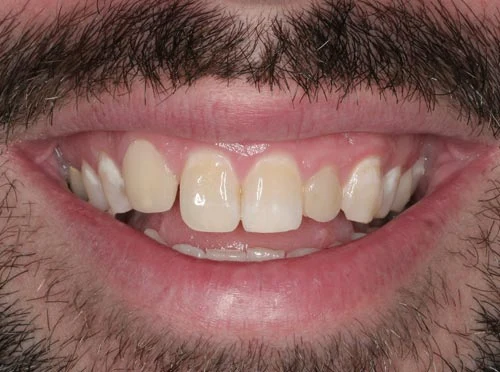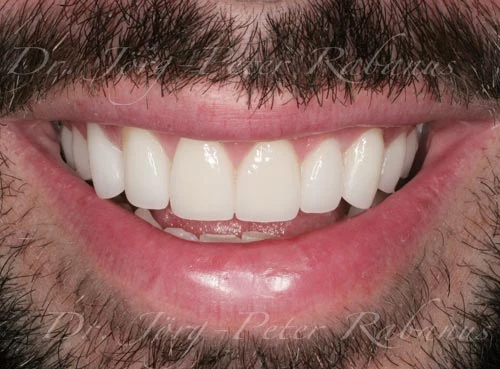Porcelain Veneers as an Option for a Smile Makeover with Missing Lateral Incisor


Many patients seeking a smile makeover with porcelain veneers present with a more complex aesthetic scenario than they initially realize. While they may assume their concerns are purely cosmetic, underlying structural and anatomical factors often complicate their treatment. One such challenge is the absence of teeth in the smile-exposed region of the dentition. Among the most commonly missing teeth are the lateral incisors, a condition that presents unique difficulties in both diagnosis and treatment.
The Importance of Early Intervention
Missing lateral incisors are best addressed early in life, ideally during adolescence, when the jaw and dentition are still developing. A comprehensive evaluation of the teeth, jaws, facial structure, and skull is necessary to determine the most effective treatment approach. In these cases, orthodontic intervention plays a critical role in either closing the spaces left by the missing lateral incisors by moving adjacent teeth forward or optimizing the space for the future placement of dental implants.
Orthodontically closing the space involves repositioning the posterior teeth, particularly the canines, into the area where the lateral incisors would normally be. This approach can be successful if properly executed but requires careful consideration of the differences between canines and lateral incisors. The other approach, preserving the space for future implants, allows for a more anatomically accurate restoration of the missing tooth structure. Both strategies require precise planning and execution to ensure a harmonious and aesthetically pleasing outcome.
The Challenge of an Uneven Gumline
A major difficulty associated with missing lateral incisors is the presence of an irregular gumline. The gingival tissue follows a natural scalloped contour, and in cases of missing teeth, these contours become disrupted. Establishing a balanced and symmetrical gumline is essential for creating the illusion of a natural and complete smile.
For orthodontists, this poses an additional challenge beyond simply moving teeth into their ideal horizontal positions. The vertical positioning of teeth must also be considered to ensure the gumline appears uniform. Without proper alignment, even the most expertly placed veneers or implants will fail to achieve an optimal aesthetic result. The role of a skilled periodontist is often crucial in refining the gumline, ensuring that the final outcome appears seamless.
The Problem with Replacing Lateral Incisors with Canines
When orthodontic space closure is chosen as the treatment method, the canine is often moved forward to take the place of the missing lateral incisor. However, this substitution is far from ideal. Lateral incisors and canines are fundamentally different in both form and function. The lateral incisor is delicate, often described as the "sexiest" and most feminine tooth in the human dentition. It is small, with a subtle curvature and a gumline that aligns with the central incisors.
In contrast, the canine is a robust, dominant tooth with a much more aggressive shape. Its gumline is naturally positioned higher than the adjacent teeth, and its width is significantly greater than that of a lateral incisor. Even with orthodontic repositioning, the challenge remains that the canine cannot be physically reduced in width without compromising the integrity of the tooth. A canine in the position of a lateral incisor will always appear bulkier and more prominent than a true lateral incisor, which can compromise the overall aesthetics of the smile.
For this reason, an alternative treatment strategy is often preferred: preserving the space for a future implant. This approach allows for the placement of a properly shaped implant crown that mimics the natural emergence profile of a lateral incisor. In many cases, this results in a more natural and aesthetically pleasing outcome compared to moving the canine forward.
Case Study: Addressing a Missing Lateral Incisor with Porcelain Veneers
The complexity of treating missing lateral incisors is well illustrated by a recent case involving a patient who sought a smile makeover. This patient, a professional in his prime, was highly conscious of his appearance but unwilling to undergo a lengthy orthodontic treatment or oral surgery. His primary concern was to improve his smile as quickly and effectively as possible with porcelain veneers.
Upon examination, it was clear that the absence of the lateral incisor created an imbalance in the patient’s smile. The upper right canine had drifted forward into the lateral incisor position, making the overall dentition appear asymmetrical. While veneers alone would provide some improvement, they would not be sufficient to fully address the underlying issues. The patient was carefully informed of his situation and presented with a comprehensive treatment plan that would optimize his results.
The proposed plan included a gum lift, also known as crown lengthening, to adjust the heights of the gumlines of the affected teeth. This procedure would help create a more balanced and symmetrical appearance, minimizing the visual impact of the misplaced canine. The patient agreed to proceed with the recommended treatment.
The Role of Periodontal Surgery in Smile Makeovers
To achieve the best possible outcome, the patient was referred to a periodontist specializing in aesthetic gum contouring. The goal was to establish a more even gingival architecture by adjusting the gum heights of the smile-exposed upper teeth. Periodontal surgery was performed, and after a two-month healing period, the gum tissue was reassessed to ensure optimal positioning.
With the gumline corrected, the next step was to create a diagnostic wax-up, a critical tool in aesthetic dentistry that allows for precise treatment planning. The wax-up provided a blueprint for designing the porcelain veneers, ensuring each veneer complemented the patient's facial features and existing dentition. Additionally, it facilitated discussions with the patient about the expected outcome, aligning his expectations with the realistic possibilities of the treatment.
The Veneer Fabrication Process
Once the patient approved the wax-up design, matrices were fabricated to guide the preparation of the teeth. These matrices helped determine the amount of tooth structure that needed to be conservatively removed to accommodate the veneers. Additionally, provisional veneers were created to allow the patient to preview the new smile design in his mouth before the final veneers were fabricated.
After a short trial period with the temporary veneers, the patient was pleased with the proposed changes. The final porcelain veneers were then crafted by a master ceramist to achieve the most natural aesthetics. Within ten days, the final restorations were ready for placement.
Final Results and Patient Satisfaction
The new porcelain veneers were meticulously inserted, ensuring proper fit, shade, and translucency. The patient's smile was dramatically transformed, achieving the balance and symmetry he desired. The gumline corrections, combined with the precise shaping of the veneers, successfully masked the underlying issues caused by the missing lateral incisor. The final result was a harmonious and natural-looking smile that enhanced the patient’s confidence and professional appearance.
This case highlights the importance of a comprehensive approach in cosmetic dentistry. Simply placing veneers without addressing foundational issues would have resulted in a suboptimal outcome. Instead, by incorporating periodontal treatment, careful planning, and high-quality porcelain restorations, the patient's smile was significantly improved in both form and function.
Conclusion
Addressing missing lateral incisors presents a complex set of challenges that require interdisciplinary collaboration between orthodontists, periodontists, and cosmetic dentists. While orthodontic space closure and canine substitution may be an option, preserving the space for a future implant often yields superior aesthetic results. For patients who are unwilling or unable to undergo lengthy orthodontic treatment, a combination of periodontal surgery and porcelain veneers can provide a highly effective alternative.
Ultimately, the key to success in these cases lies in meticulous planning, a deep understanding of dental aesthetics, and a commitment to achieving the most natural-looking results possible. With the right approach, even complex cases involving missing lateral incisors can be transformed into stunning, confident smiles.
References:
Dennis J Wells. The Lateral Incisor: The Unsung Hero in Smile Design. The American Academy of Cosmetic Dentistry Journal, Vol. Fall, pp. 38-46.
Predictable Tooth Replacement in the Aesthetic Zone. Bassett JL. Dentistry Today, 2014; March, 76-83.
Solutions for atypical problems in the incisors area: a transdisciplinary challenge. Costa Sobral M. Dental Press J Orthod. 2020; 25(2): 86–102.
Anterior Tooth Challenges, Part 4 Canines in the Lateral Position. Mechanic E. Dentistry Today, 2014; March, 84-89.
Prandter O. Consequences and solutions in agenesis of the lateral incisors - Partial Anodontia. Teamwork, 2008, 1-11.
Agenesis of maxillary lateral incisors: diagnosis and treatment options. Kimaid Schroeder D et al. Dental Press J Orthodontics. 2022; 27(1): e22spe1.
Maxillary anterior single-tooth replacement: comparison of three treatment modalities. Studer S. Pract Period Aesthetic Dentistry, 1994; 6(1), 51-60.
Aria J. Implant and Adjacent Veneers Pose a Challenging Esthetic Situation - Immediate Surgical and Restorative Implant Procedure Outlined. J Cosmetic Dentistry, 2015; 30(4), 60-70.
Implant-supported restorations in the anterior region: prosthetic considerations. Belser UC. Pract Period Aesthetic Dentistry, 1996; 8(9), 875-883.
Smile design for the adolescent patient--interdisciplinary management of anterior tooth size discrepancies. Waldman AB. J Calif Dental Assoc, 2008; 36(5), 365-372.
An interdisciplinary approach to aesthetic single implant outcomes for young patients. Priest GF. Pract Proced Aesthetic Dentistry, 2008, 20(3), 167-175.
Multidisciplinary Care: Periodontal Aspects to Treatment Planning the Anterior Esthetic Zone. Ravon NA. Calif Dental Assoc Journal, 2008; 36(8), 575-584.
Bhuvaneswaran M. Tooth Replacement in the Esthetic Zone Synergy and Success for Accreditation Case Type III. J Cosmetic Dentistry, 2014; 30(2), 30-37.
Alammari R. et al. Minimally invasive management of missing maxillary lateral incisors. J Cosmetic Dentistry, 2014; 30(3), 38-46.
A conservative aesthetic solution for a single anterior edentulous space: case report and one-year follow-up. Leal FR. Pract Proc Aesthetic Dentistry, 2001; 13(8), 635-641.
Lowe E et al. Replacing congenitally missing lateral incisors and enhancing soft-tissue esthetics with metal-free three-unit fixed restorations. J Cosmetic Dentistry, 2009; 25(2), 100-109.
Esthetics and anterior tooth position: an orthodontic perspective. Part III: Mediolateral relationships. Kokich V. J Esthetic Dentistry, 1993; 5(5), 200-207.
Achieving gingival esthetics. Reddy MS. J Am Dental Assoc, 2003; 134(3), 295-304.
Challenges in Achieving Gingival Harmony. Simon Z et al. CDA Journal, 2010; 38(8), 583-590.
The aesthetic guidelines of the mucogingival complex for fixed prosthodontics. Studer S. Pract Period Aesthetic Dentistry, 1996; 8(4), 333-341.
The perio-aesthetic-restorative approach for anterior reconstruction--Part I: Evaluation and periodontal surgery. Terry DA et al. Pract Proced Aesthetic Dentistry, 2002; 14(4), 283-291.
Restoration Modalities of Severely Injured Anterior Teeth—Gingival Integration, Papillae Support, and Predictable Imperfections. Bichacho N. Compendium, 2003; 24(12), 891-904.
Bakemann EM. The rolled pedicle graft for Class I ridge defects. Teamwork, 2008; 1(4), 32-37.
Bakemann EM. Replacing a Missing Tooth in the Aesthetic Zone: Accreditation Case Type III. American Academy of Cosmetic Dentistry Monograph, 2007, 1-6.
Landsberg CJ et al. SEQUENCING of Periodontal Procedures and Orthodontic Treatment For Long-Term Esthetic Outcome: A 5-Year Case Report. J Cosmetic Dentistry, 2014; 29(4), 46-58.
Porcelain veneers are a remedy for a variety of cosmetic dental conditions. Dr. Jorg-Peter Rabanus is San Francisco's top cosmetic dentist. He excels in creating comprehensive smile makeovers with porcelain veneers.




